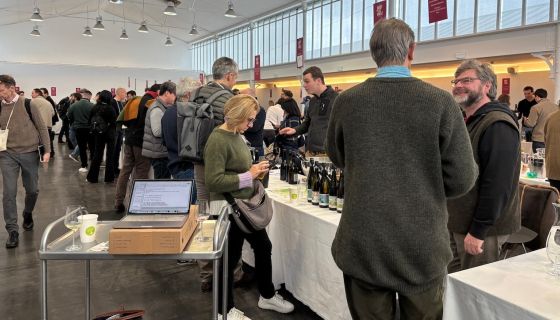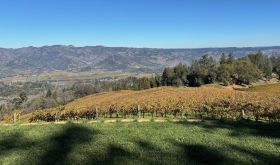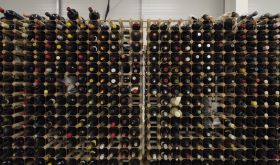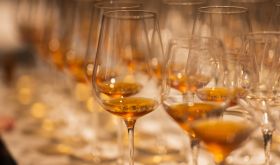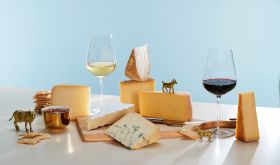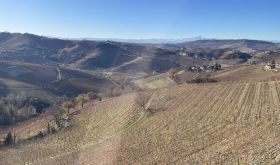In early February I was coming back from a lovely sunny break in Marrakech (see my reviews of Moroccan wines) and had to attend a dinner immediately before the increasingly successful Wine Paris trade fair to accept an award on behalf of my Australian wine-writer colleague James Halliday.
Not surprisingly, there are multiple flights from Marrakech to Paris so it seemed sensible to take one of them and then the train back to London. To ensure I was on time for the Sunday night dinner, I was asked to fly in on the Saturday afternoon and so had a Saturday evening and all day Sunday to kill.
Yes, of course I should have spent Sunday in the Louvre, or the Musée d’Orsay, but then my friend Mark Williamson of Willi’s Wine Bar (with his back to us in the foreground above) told me that on the Sunday morning he was planning to attend a really good wine tasting with the splendid name of Haut les Vins, ‘long live wine’, so of course I joined him, before a late lunch at the Clown Bar.
I’d spent Saturday evening with friends in Juveniles wine bar round the corner from Willi’s and founded by his former business partner Tim Johnston so I’m afraid there was a certain anglo-wine theme to my short stay in the French capital. I really did mean to try to get into the restored Notre Dame, having failed to penetrate the crowds on a day trip to Paris in early January, but when I woke up on Sunday morning it was cold and rainy. And my bed was extremely comfortable.
I’d never consciously heard of Haut les Vins but when I examined my inbox I saw that since 2018 I had been invited to their tastings held on the eve of the major European wine trade fairs in Düsseldorf and now Paris. The initiative was born in 2007 ‘from the strong connections between fellow producers when travelling with the importers we share in various countries. It’s a long story and we still enjoy these moments a lot’, according to the founder Laurence Texier. She’s the wife and mother respectively of wine producers Eric and Martin Texier. The location of the Texiers’ vineyards provides a clue to the genesis of these wine tastings.
The Texiers make distinctive, artisanal wines in a sort of no man’s land of the Rhône Valley between Valence and Montélimar so are allowed no appellation more precise than Côtes du Rhône, one of the most extensive appellations in France. Creating a reputation for their wines therefore has not been easy. Like the other vignerons showing their wines that Sunday, they believe passionately (forgive me for this apt but overused word) in wines driven by terroir.
According to the Haut les Vins manifesto, which complains about the standardisation of wines, the wines they showcase share the goal of ‘a return to more nuance and sensitivity and remain closer to the natural character of wine by rejecting the systematic use of techniques championed by agronomy and modern oenology’. All these vignerons are relatively small-scale family affairs – typically practising organic, biodynamic or regenerative viticulture and minimal intervention in the cellar. They can undoubtedly make more noise by joining together rather than by acting alone.
They are not helped by the fact that France has no effective national distribution system for wine, so an event on the eve of a trade fair is ideal for meeting a maximum number of potential customers rather than depending on them to visit their domaines. But I was intrigued to see from the list of exhibitors sent to me in advance that this was not an all-French showing. There were wine producers from Germany, Austria, Spain, Hungary, Italy, Portugal, Slovenia and Switzerland. The great majority of them, however, had come from all over France (but not the fancy appellations unless you count the lone champagne, Tarlant). They were supplemented by a Norman cider and calvados producer and one cognac distiller, Fanny Fougerat.
Curious, I trooped along to the Maison des Métallos artspace in – where else? – the 11th arrondissement, the Shoreditch of Paris, and was struck by the evident bonhomie. The exhibitors are deliberately mixed up, to promote as much useful discussion between them as possible, which is not so helpful for visitors trying to work their way through the tasting booklet that profiles every enterprise. It doesn’t, however, list the wines on show, presumably to allow producers to choose at the last minute which bottles to bring. A Mexican food truck had thoughtfully been provided just outside to keep exhibitors by their tables for as long as a groaning stomach would allow.
Looking down the list of about 60 vignerons, I realised I knew only about 17 of them, so set about educating myself. There was not an industrial-tasting wine among them. And I did learn a great deal, although many of the exhibitors brought so many wines that it was impossible to taste them all. What I did notice was how many inventive, difficult-to-remember names the wines had, and how many wines were labelled not with an appellation, nor as an IGP, the less demanding geographical denomination, but the simple Vin de France, which allows producers even more freedom.
One problem was that it was the most recent vintages of these characterful wines that were shown in Paris and far too few of them are available yet in the UK.
One of the most impressive ranges of wines was from a producer well outside France, Vino Gross of Slovenia, represented by Maria and Michael Gross, who, according to the profile they submitted for the catalogue, are trying to teach their young children ‘a conscious and open approach to their environment’.
But I mainly learnt a great deal about some of the lesser-known wine regions of France. Yann de Agostini of Domaine du Petit Août came to Paris from the high plateau of the Hautes-Alpes around the town of Gap and told me there are now 11 vignerons growing vines here, up to 700 m. He began in 2009 and was certified organic by 2013. His wine names are particularly creative (Le Poids du Superflu, for instance) but I especially appreciated his reds based on the very local grape Mollard.
Camille and Thomas Fort of Domaine de Mouscaillo in Limoux had come from the far south-west and showed me yet again how good the Pinot Noir grown in these Pyrenean foothills can be.
Producers from south-west France were especially interesting, and included a couple trying to make new-wave wines in Bordeaux. I was also struck by Marc and Thibaut Penavayre from Domaine Plaisance Penavayre in the little Fronton appellation north of Toulouse. According to them, it was ‘dying five years ago’ but now there’s a new dynamism. They are campaigning to get a special new appellation for Fronton Blanc made from their local grape Bouysselet.
Fortunately I did very much like the wines of the husband of the Haut les Vins organiser, Eric Texier. He reported that the influential Perrin family from the southern Rhône (Château de Beaucastel in Châteauneuf-du-Pape, Miraval Provençal rosé with Brad Pitt, etc) have been buying extensively in his area. ‘So Brézème will presumably have its own appellation soon. It took me 10 years to do what the Perrins have done in one’, he observed ruefully.
Hollywood connections clearly help, even in the wilds of the Rhône Valley.
Recommendations
Domaine de Mouscaillo Pinot Noir 2023 IGP Haute Vallée de l’Aude 13.5%
2022 is £14.95 The Wine Society but currently out of stock
Domaine Capmartin, Agrumes & Caetera 2023 Pacherenc du Vic-Bilh Sec 13%
2022 is £19.99 Quaff Fine Wine
Eric Texier, Brézème 2023 Côtes du Rhône 12.5%
2022 is £27 xTraWine UK, £29.95 The Fine Wine Co
Domaine Plaisance Penavayre, Tot Ço Oue Cal 2022 Fronton 12.5%
£27.82 Les Caves de Pyrène
Vino Gross, Korže 2022 Stajerska Slovenia 13.5%
2021 is £68 Newcomer Wines
For full tasting notes, scores and suggested drinking dates from the event, see Haut les Vins – the wines. For international stockists, see Wine-Searcher.com.
Back to basics
| Vin de France – a popular new thing |
|
In the 1930s the French gave birth to controlled appellations, their much-copied system of appellations contrôlées, whereby producers of wines (plus spirits and all sort of foodstuffs) proudly boast where their produce comes from and have to obey all sorts of rules governing how it is made. Pages and pages of regulations govern not just the specific area but things like which grape varieties are allowed, maximum crop levels, how ripe the grapes have to be, possibly a minimum or maximum alcohol level, how many vines should be planted per hectare, how the vines are trained – even, for some appellations, how the wine is made.
This contrasts markedly with the situation outside Europe, where the exact boundaries of a wine region are set (‘delimited’) but within them, producers are generally free to grow and do what they want.
It is now the norm for younger French vignerons to travel widely, so they tend to have been exposed to these much more liberal wine regimes, and there is another reason more and more of them want to escape the rigid rules of a controlled appellation. For a wine to be approved for a controlled European appellation, it generally has to be approved by a tasting committee. Members of the tasting committees tend to be older wine producers with much more conservative ideas of how wines from a given appellation should taste. Producers pushing the boundaries, perhaps the result of extended maceration with grape skins, or with such a low level of preservative sulphites that the wine doesn’t smell as fresh as conventional wine, have often been exasperated to see their wines rejected by the relevant appellation tasting panel.
The result of all this has been a dramatic increase in the proportion of French wines sold simply as Vin de France, a category created in 2009 to replace Vin de Table for wines that claim no particular geographical origin and can be grown and made any old way.
The same phenomenon can be seen in other European countries where many new-wave winemakers choose to label their wines simply as, for instance, Vino d’Italia, Vino de España, Vinho de Portugal, Deutscher Wein and Wein aus Österreich.
Many exciting wines, made with just as much care as more conventional ones, fall into these categories. In fact the names are worn almost as a badge of honour by many producers. The only drawback I can see is that it’s difficult for us consumers to know how they are likely to taste. Vins de France may be labelled with a grape variety and/or vintage but no more specific geographical clues can be given than the address of the producer, which is by no means sufficient for most of us.
It's not uncommon for restaurants in France with a keen interest in wine, however, to group their Vins de France by region in their wine lists. Helpful. |
| See also Arise, lowly Vin de France. |

